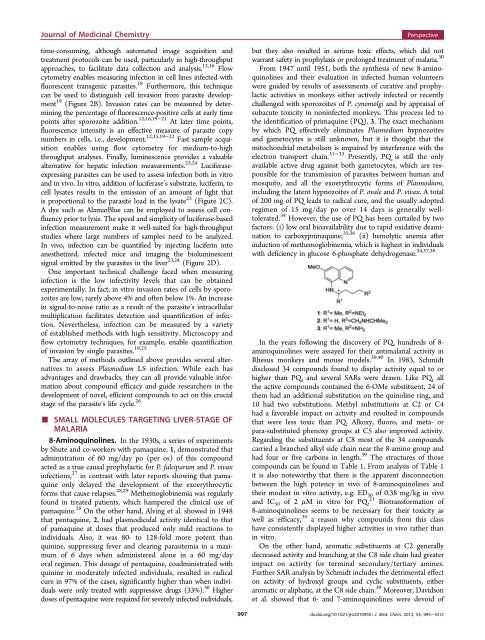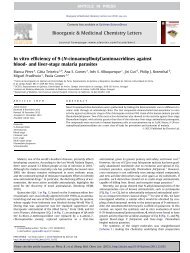Targeting the Liver Stage of Malaria Parasites - American Chemical ...
Targeting the Liver Stage of Malaria Parasites - American Chemical ...
Targeting the Liver Stage of Malaria Parasites - American Chemical ...
You also want an ePaper? Increase the reach of your titles
YUMPU automatically turns print PDFs into web optimized ePapers that Google loves.
Journal <strong>of</strong> Medicinal Chemistrytime-consuming, although automated image acquisition andtreatment protocols can be used, particularly in high-throughputapproaches, to facilitate data collection and analysis. 12,16 Flowcytometry enables measuring infection in cell lines infected withfluorescent transgenic parasites. 18 Fur<strong>the</strong>rmore, this techniquecan be used to distinguish cell invasion from parasite development19 (Figure 2B). Invasion rates can be measured by determining<strong>the</strong> percentage <strong>of</strong> fluorescence-positive cells at early timepoints after sporozoite addition. 12,16,19−21 At later time points,fluorescence intensity is an effective measure <strong>of</strong> parasite copynumbers in cells, i.e., development. 12,15,19−22 Fast sample acquisitionenables using flow cytometry for medium-to-highthroughput analyses. Finally, luminescence provides a valuablealternative for hepatic infection measurements. 23,24 Luciferaseexpressingparasites can be used to assess infection both in vitroand in vivo. In vitro, addition <strong>of</strong> luciferase’s substrate, luciferin, tocell lysates results in <strong>the</strong> emission <strong>of</strong> an amount <strong>of</strong> light thatis proportional to <strong>the</strong> parasite load in <strong>the</strong> lysate 23 (Figure 2C).A dye such as AlamarBlue can be employed to assess cell confluencyprior to lysis. The speed and simplicity <strong>of</strong> luciferase-basedinfection measurement make it well-suited for high-throughputstudies where large numbers <strong>of</strong> samples need to be analyzed.In vivo, infection can be quantified by injecting luciferin intoanes<strong>the</strong>tized, infected mice and imaging <strong>the</strong> bioluminescentsignal emitted by <strong>the</strong> parasites in <strong>the</strong> liver 23,24 (Figure 2D).One important technical challenge faced when measuringinfection is <strong>the</strong> low infectivity levels that can be obtainedexperimentally. In fact, in vitro invasion rates <strong>of</strong> cells by sporozoitesare low, rarely above 4% and <strong>of</strong>ten below 1%. An increasein signal-to-noise ratio as a result <strong>of</strong> <strong>the</strong> parasite’s intracellularmultiplication facilitates detection and quantification <strong>of</strong> infection.Never<strong>the</strong>less, infection can be measured by a variety<strong>of</strong> established methods with high sensitivity. Microscopy andflow cytometry techniques, for example, enable quantification<strong>of</strong> invasion by single parasites. 19,25The array <strong>of</strong> methods outlined above provides several alternativesto assess Plasmodium LS infection. While each hasadvantages and drawbacks, <strong>the</strong>y can all provide valuable informationabout compound efficacy and guide researchers in <strong>the</strong>development <strong>of</strong> novel, efficient compounds to act on this crucial■stage <strong>of</strong> <strong>the</strong> parasite’s lifecycle. 26SMALL MOLECULES TARGETING LIVER-STAGE OFMALARIA8-Aminoquinolines. In <strong>the</strong> 1930s, a series <strong>of</strong> experimentsby Shute and co-workers with pamaquine, 1, demonstrated thatadministration <strong>of</strong> 60 mg/day po (per os) <strong>of</strong> this compoundacted as a true causal prophylactic for P. falciparum and P. vivaxinfections, 27 in contrast with later reports showing that pamaquineonly delayed <strong>the</strong> development <strong>of</strong> <strong>the</strong> exoerythrocyticforms that cause relapses. 28,29 Me<strong>the</strong>moglobinemia was regularlyfound in treated patients, which hampered <strong>the</strong> clinical use <strong>of</strong>pamaquine. 28 On <strong>the</strong> o<strong>the</strong>r hand, Alving et al. showed in 1948that pentaquine, 2, had plasmodicidal activity identical to that<strong>of</strong> pamaquine at doses that produced only mild reactions toindividuals. Also, it was 80- to 128-fold more potent thanquinine, suppressing fever and clearing parasitemia in a maximum<strong>of</strong> 6 days when administered alone in a 60 mg/dayoral regimen. This dosage <strong>of</strong> pentaquine, coadministrated withquinine in moderately infected individuals, resulted in radicalcure in 97% <strong>of</strong> <strong>the</strong> cases, significantly higher than when individualswere only treated with suppressive drugs (33%). 30 Higherdoses <strong>of</strong> pentaquine were required for severely infected individuals,Perspectivebut <strong>the</strong>y also resulted in serious toxic effects, which did notwarrant safety in prophylaxis or prolonged treatment <strong>of</strong> malaria. 30From 1947 until 1951, both <strong>the</strong> syn<strong>the</strong>sis <strong>of</strong> new 8-aminoquinolinesand <strong>the</strong>ir evaluation in infected human volunteerswere guided by results <strong>of</strong> assessments <strong>of</strong> curative and prophylacticactivities in monkeys ei<strong>the</strong>r actively infected or recentlychallenged with sporozoites <strong>of</strong> P. cynomolgi and by appraisal <strong>of</strong>subacute toxicity in noninfected monkeys. This process led to<strong>the</strong> identification <strong>of</strong> primaquine (PQ), 3. The exact mechanismby which PQ effectively eliminates Plasmodium hypnozoitesand gametocytes is still unknown, but it is thought that <strong>the</strong>mitochondrial metabolism is impaired by interference with <strong>the</strong>electron transport chain. 31−33 Presently, PQ is still <strong>the</strong> onlyavailable active drug against both gametocytes, which are responsiblefor <strong>the</strong> transmission <strong>of</strong> parasites between human andmosquito, and all <strong>the</strong> exoerythrocytic forms <strong>of</strong> Plasmodium,including <strong>the</strong> latent hypnozoites <strong>of</strong> P. ovale and P. vivax. A total<strong>of</strong> 200 mg <strong>of</strong> PQ leads to radical cure, and <strong>the</strong> usually adoptedregimen <strong>of</strong> 15 mg/day po over 14 days is generally welltolerated.34 However, <strong>the</strong> use <strong>of</strong> PQ has been curtailed by tw<strong>of</strong>actors: (i) low oral bioavailability due to rapid oxidative deaminationto carboxyprimaquine; 35,36 (ii) hemolytic anemia afterinduction <strong>of</strong> me<strong>the</strong>moglobinemia, which is highest in individualswith deficiency in glucose 6-phosphate dehydrogenase. 34,37,38In <strong>the</strong> years following <strong>the</strong> discovery <strong>of</strong> PQ, hundreds <strong>of</strong> 8-aminoquinolines were assayed for <strong>the</strong>ir antimalarial activity inRhesus monkeys and mouse models. 39,40 In 1983, Schmidtdisclosed 34 compounds found to display activity equal to orhigher than PQ, and several SARs were drawn. Like PQ, all<strong>the</strong> active compounds contained <strong>the</strong> 6-OMe substituent, 24 <strong>of</strong><strong>the</strong>m had an additional substitution on <strong>the</strong> quinoline ring, and10 had two substitutions. Methyl substitutions at C2 or C4had a favorable impact on activity and resulted in compoundsthat were less toxic than PQ. Alkoxy, fluoro, and meta- orpara-substituted phenoxy groups at C5 also improved activity.Regarding <strong>the</strong> substituents at C8 most <strong>of</strong> <strong>the</strong> 34 compoundscarried a branched alkyl side chain near <strong>the</strong> 8-amino group andhad four or five carbons in length. 39 The structures <strong>of</strong> thosecompounds can be found in Table 1. From analysis <strong>of</strong> Table 1it is also noteworthy that <strong>the</strong>re is <strong>the</strong> apparent disconnectionbetween <strong>the</strong> high potency in vivo <strong>of</strong> 8-aminoquinolines and<strong>the</strong>ir modest in vitro activity, e.g. ED 50 <strong>of</strong> 0.38 mg/kg in vivoand IC 50 <strong>of</strong> 2 μM in vitro for PQ. 21 Biotransformation <strong>of</strong>8-aminoquinolines seems to be necessary for <strong>the</strong>ir toxicity aswell as efficacy, 34 a reason why compounds from this classhave consistently displayed higher activities in vivo ra<strong>the</strong>r thanin vitro.On <strong>the</strong> o<strong>the</strong>r hand, aromatic substituents at C2 generallydecreased activity and branching at <strong>the</strong> C8 side chain had greaterimpact on activity for terminal secondary/tertiary amines.Fur<strong>the</strong>r SAR analysis by Schmidt includes <strong>the</strong> detrimental effecton activity <strong>of</strong> hydroxyl groups and cyclic substituents, ei<strong>the</strong>raromatic or aliphatic, at <strong>the</strong> C8 side chain. 39 Moreover, Davidsonet al. showed that 6- and 7-aminoquinolines were devoid <strong>of</strong>997dx.doi.org/10.1021/jm201095h | J. Med. Chem. 2012, 55, 995−1012



